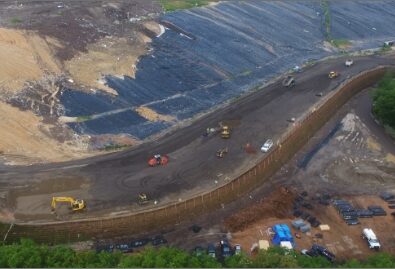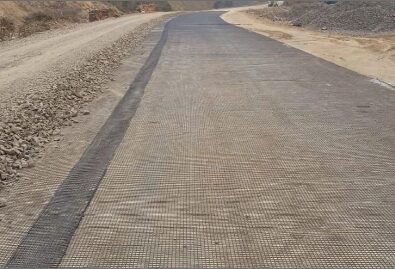
What is a geogrid?
Geogrids are geosynthetic materials that act like a strong mesh or grid to strengthen unstable ground and reinforce soil structure. They have high tensile strength and a higher elastic modulus than soil, allowing them to distribute loads more effectively and provide reinforcement in construction applications than they otherwise would.
Geogrids are used for soil reinforcement, reinforcement of retaining walls, slope stabilization, etc. Geogrids are formed by intersecting grids of elements extending in two directions, one in the machine direction (longitudinal) and the other in the transverse (or cross-machine) direction, forming the shape of the apertures. These apertures vary depending on application and the manufacturer’s specifications. Companies make geogrids from different plastic materials like polyester, polyvinyl alcohol, polyethylene, or polypropylene. At Strata Geosystems, we manufacture Polyethylene Terephthalate geogrids, also known as PET geogrids.

There are four kinds of geogrids: uniaxial, biaxial, triaxial, and composite. We at Strata Geosystems specialize in uniaxial and biaxial geogrids, which form the backbone of many soil reinforcement and ground improvement applications. Uniaxial geogrids are oriented in the longitudinal direction of the extruded sheet of polymer, giving a mesh structure of long and narrow ribs. Biaxial geogrids extend in both longitudinal and transverse directions so that the stress is uniformly distributed on both sides. Geogrids work primarily by interacting with granular soils (like sand and gravel), where the soil particles penetrate the apertures and get interlocked. This interlocking increases the shear capacity of the granular infill. Other advantages include soil stabilization, increased load-carrying capacity, and resistance to erosion.
How were geogrids invented?
The original concept of a geogrid was put forth by Dr. Brian Mercer through the patented ’ Netlon Process ’ in the late 1950s and early 1960s. The Netlon Process involves melting polymer and extruding it through a specialized die to produce a net structure that is integral in design. In the early 1970s, the use of extruded polymer mesh structures became popular in civil engineering, much like where we are with geogrids today. There are various forms of geogrids, such as extruded, woven, or welded/bonded (for example, ultrasonically) geogrids, each with different properties and uses.

What are the applications of geogrids?
Geogrids are utilized in civil engineering projects intended for soil stabilization and erosion control. Geogrids are a natural solution and an inexpensive option for subgrade development when dealing with the natural challenges associated with land construction. Civil engineers must consider various factors depending on the land that is being developed. At Strata Geosystems, we are committed to providing assistance throughout the planning and consultation process. Some common applications of geogrids are:
1. Embankments over soft soils:
Geogrids are used to provide reinforcement and stabilisation for embankments built over soft soils. By stabilising the subgrade, confining it, they minimise lateral movement and provide strength and better load bearing to weak soil areas.
2. Soil mass stabilisation:
Geogrids provide structural reinforcement to the soil mass on a slope, enhancing overall stability and enabling the safe construction of steep and durable structures.
3. Roadway improvements:
Geogrids are used in road and pavement construction to improve the mechanical properties of the subgrade soil. They help distribute traffic loads, reduce rutting and cracking, & extend the lifespan of the road infrastructure.
4. Reinforced steep slopes:
Geogrids are used to stabilize and reinforce steep slopes, which promotes stability and reduces the risk of erosion. At Strata Geosystems, our geogrids are comprised of polyester, or PET, which is suitable for soil interlocking under different topographic conditions. This confinement within the apertures provides slope stability.
5. Retaining walls:
Construction crews layer geogrids horizontally throughout the soil behind retaining walls to create stronger, more stable backfill. This reinforced soil can stand at sharper angles without collapsing and puts less pressure against the wall itself. Engineers can often use cheaper dirt from the construction site rather than having to truck in expensive imported fill material.
6. Landfill construction:
Geogrids find application in landfill construction for reinforcing steep slopes and providing foundational support for landfill expansions.
7. Slope stabilization:
Geogrids are used to reinforce soil on unstable slopes by interlocking with granular fill. This reduces lateral movement, improves shear resistance, & provides a long-term stabilisation solution, especially in areas with weak subgrades or steep gradients.
8. Paving support and base layer reinforcement:
While crews typically use glass-fiber grids when adding new asphalt layers on top of existing pavement, Strata’s PET geogrids work best in the foundation layers underneath roads. Engineers install them to help the pavement carry heavier loads, prevent ruts from forming, and make roads last longer before needing major repairs.
Strata’s PET geogrids are used below pavement layers to reinforce weak subgrades, reduce rutting and cracking, and improve pavement longevity. This approach lowers maintenance needs and extends service life for both asphalt and concrete roads.

Uses of geogrids in civil engineering:
Geogrids are chosen for their structure in construction and due to their unique properties. Principally working to stabilize or reinforce soil, geogrids are used in different industries.
1. Working Platforms Over Soft Soils:
Geogrids assist in constructing stable working surfaces above weak ground by encapsulating the aggregate layer in particle interlock within their apertures. The reinforcement enhances the load-carrying capacity of the soil as well as reduces settlement. Soft soils, in the absence of reinforcement, settle under traffic or structural loads, resulting in uneven surfaces & possible damage.
2. Extending Pavement Service Life
Enhancing a pavement’s service life by reducing iterative maintenance costs. Geogrids can help with reducing rutting, cracking, & other typical issues that occur with paved roads, be it asphalt or concrete.
3. Optimizing Roadway Cross-Sections
Reducing the structural cross-section of both paved and unpaved roadways for a given service life. Geogrids reduce the stress transferred to the subgrade by improving the shear strength of the reinforced soil layer.
4. Reducing Aggregate Requirements
The SGB biaxial geogrids from Strata occupy a unique niche in the market as they reduce the thickness of aggregate layers in unpaved roads and working platforms (a 50% reduction in base thickness) by restricting particle movement and distributing load more efficiently. This leads to faster construction and a lower cost of materials.
5. Lowering Maintenance Costs
In paved & unpaved roads alike, geogrid reinforcement reduces rutting and base deformation. Strata’s SGB biaxial geogrids engage with aggregates to enhance load distribution & shear strength. This minimizes structural damage and the requirement for regular repairs. In most instances, this has also resulted in substantial savings on maintenance costs, although actual amounts differ by project.
6. Slope stabilization in highways, landfills, and rail embankments
Strata’s PET uniaxial geogrids improve slope stability for highways, landfills, and railway embankments, particularly in erosion or seismic areas. They restrain soil and enhance shear resistance, making mass movement impossible. In green infrastructure, StrataGrid™ is typically used with StrataWeb® geocells to sustain vegetated facades and long-term slope stability.
7. Reinforcement across infrastructure sectors
Geogrids are widely used in highways, railways, airfields, & urban infrastructure to stabilize subgrades and minimize deformation. Strata’s biaxial SGB Grid has been utilized beneath national highways, taxiways, container terminals, and parking lots for settlement control and pavement life extension. In railways, it provides improved ballast stability, whereas in airfields, it makes thinner granular layers possible without loss of structural performance.
What are construction projects completed by Strata Geosystems using geogrids?

1. Egg Harbor Township, New Jersey, USA:
Strata Geosystems was involved in a project at the Atlantic County Utilities Authority (ACUA) landfill in Egg Harbor Township, New Jersey. The project focused on the vertical expansion of the landfill to accommodate more solid waste over the next twenty years. Strata’s solution was to build a peripheral Mechanically Stabilised Earth (MSE) berm outside the current berm to raise the height of the landfill. This new way enabled waste capacity expansion without increasing the landfill footprint. Strata also proposed using reclaimed asphalt pavement (RAP) and StrataGrid master rolls to ensure a flexible and stable structure, capable of withstanding differential settlement.

2. Kohima Bypass Road, Nagaland:
Strata Geosystems was involved in the implementation of a durable and flexible pavement solution using StrataGrid biaxial pavement. The objective of the project was to resolve the issues of building a high-traffic way in the hilly & remote areas of North-East India. The solution in this case was opting for StrataGrid biaxial instead of traditional methods because it helps decrease pavement thickness, lowers the consumption of natural materials, and reduces maintenance intervals. The design considered a subgrade California Bearing Ratio (CBR) of 10% and traffic intensity of 50 MSA, with two SGB Grid layers in the Wet Mix Macadam (WMM) and granular sub-base.
The confining influence of the SGB Grid stabilized the pavement section under traffic loads, limiting vertical & lateral aggregate movement. This groundbreaking solution made installation easy, saved natural materials, enhanced fatigue & rutting design life, and allowed for cost-effective and quick construction, demonstrating the functionality of Strata’s geotechnical products in the construction of infrastructure.
Contact our team of geotechnical professionals to see how Strata’s geogrid solutions can change your project results – whether they are for roads, landfills, or reinforced walls. We can help you select the right product, optimize designs, & execute faster with proven systems like StrataGrid™, SGB Grid, & biaxial PET geogrids.
Reach out to us today, and let’s start designing infrastructure that is stronger and will last longer.
